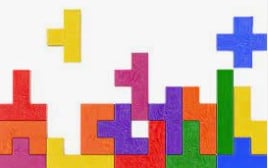Did you know that our visual skills start developing from birth? We are not born with fully functioning visual systems. For some children, the process runs smoothly and they have fully developed visual skills by around the age of 9 but for many children, their visual skills do not develop as expected. This can have a huge impact on their ability to learn in a classroom environment particularly on reading and writing.
Visual perceptual skills are the brain’s ability to make sense of what the eyes see. It is important for everyday activities such as dressing, eating, writing, and playing. There are seven different categories of visual perceptual skills. We will review each of these categories over the next few days, as well as some visual perceptual activities that are helpful for children.
1. Visual Spatial Relations
Visual spatial relations is the ability to determine one form or part of a form that is turned in a different direction than the others. This is why some of our children have such a hard time recognizing b and d or p and q. They don’t understand that just because it’s rotated, it’s a different letter. They also have difficulty differentiating between in and out, over and under, and left and right, because those are spatial skills concepts.
Activities to Improve Visual Spatial Relations
Some gross motor activities to help practice visual spatial skills include:
-Crawling under and through objects without touching them i.e. table, chairs, ropes
-Doing gross motor activities with eyes closed
-Completing obstacle courses
-Riding a bicycle around an obstacle course
-Climbing activities
-Locating objects in relation to oneself i.e. in front of, behind, to the left of etc.
-Imitating body positions
-Locating objects from verbal or written instructions
Some fine motor activities to help practice visual spatial skills include:
-Copying shapes from one piece of paper to another in the same position
-Copying 3D block and lego designs
-Puzzles
-Sorting shapes, pictures, symbols, sequences and words into same or different groups.
-Activities that require the child to determine the object that is different or going the wrong way in a group of objects.

